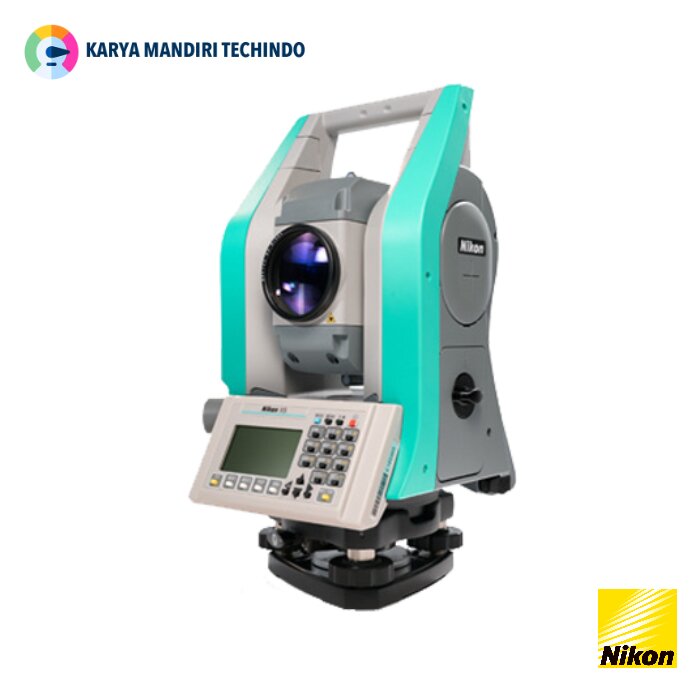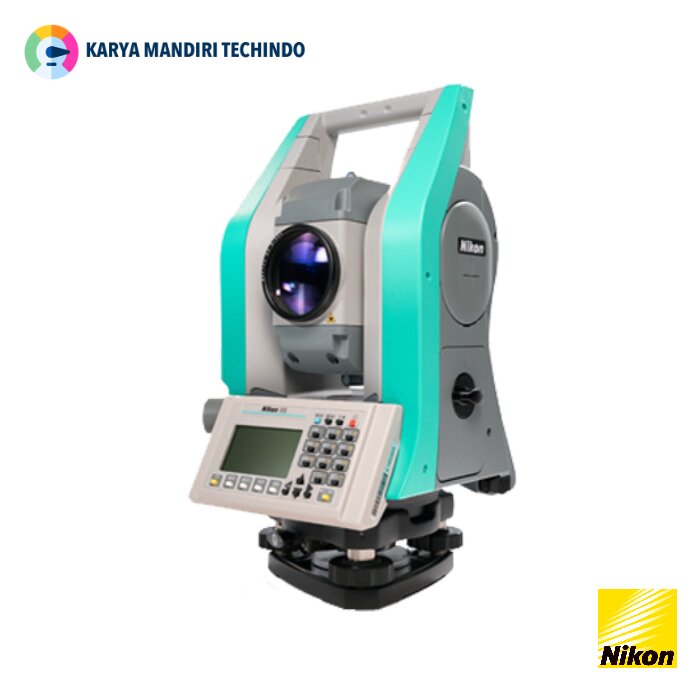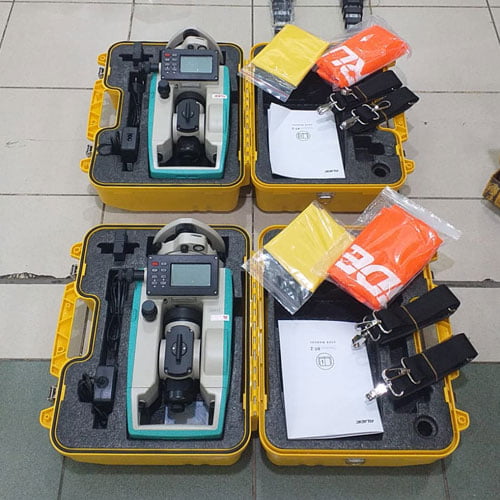Product Description
Nikon NPL-322+2″P Total Station
Karya Mandiri Techindo has a wide range of Nikon products – search by type, or model, or filter by brand to find the one you are after. If you still can’t find it contact us..
NPL-322+ Series
The Nikon NPL-322+ Series of mechanical total stations includes a 2″ dual face and 5″ single face models. Both NPL-322+ models feature dual axis compensation to correct for errors in
tilt in the horizontal and vertical axes, a reflectorless EDM with 400 meter (1300 feet) range, wireless Bluetooth connections to external data collectors and 50,000 point onboard storage.
Using the same rechargeable long life Li-ion battery as the Nivo series, combined with low power consumption design, the NPL-322+ provides the longest possible time in the field. For
convenience, the Nikon NPL-322+ total stations include two batteries and a dual charger, to support even the longest of working days.
The NPL-322+ Total Station delivers an economic, versatile, and easy-to-use platform to ensure you get the job done right. Nikon’s legendary optics effectively allow in more light to give you
brighter, clearer images. You’ll see the difference when you look through a Nikon Total Station even in the low-visibility conditions typical in the field. You’ll see much more detail and much
less distortion, especially over longer distances. Better optics help you aim more precisely, and they’re much easier on your eyes – something you’ll really appreciate on long workdays.
Features Nikon NPL-322+2″P Total Station :
- 2″angle accuracies
- Prism and reflectorless measurements
- Fast, accurate EDM
- Convenient and long-lasting Li-ion battery
- Easy-to-use keypad
- Rugged and lightweight
- Bluetooth enabled
- Dual axis compensation
Specifications Nikon NPL-322+2″P Total Station :
Distance measurement
- Range with Nikon specified prisms
– Good conditions (No haze, visibility over 40 km (25 miles)) With reflector sheet (5 × 5 cm):
1.5 m to 200 m (4.9 ft to 787 ft)
With single prism 6.25 cm (2.5 in):
3,000 m (9,840 ft)
- Range reflectorless mode
– KGC (18%)1
Good: 250 m (820 ft)
Normal: 200 m (656 ft)
Difficult: 150 m (492 ft)
– KGC (90%)1
Good: 400 m (1312 ft)
Normal: 350 m (1148 ft)
Difficult: 250 m (820 ft)
- Accuracy ISO 17123-4 (Precise mode)
– Prism2 : ±(2+2 ppm × D) mm
– Reflectorless/Reflector sheet3 :
±(3+3 ppm × D) mm
- Measuring interval4
– Prism mode
Precise mode: 1.1 sec.
Normal mode: 0.8 sec.
– Reflectorless mode
Precise mode: 1.2 sec.
Normal mode: 1.0 sec.
– Least count
Precise mode: 1 mm (0.002 ft)
Normal mode: 10 mm (0.02 ft)
Angle Measurement
- ISO 17123-3 accuracy (horizontal and vertical): 2″/0.6 mgon, 5″/1.5 mgon
- Reading system: Photoelectric detection by incremental encoder
- Circle diameter: 88 mm (3.46 in)
- Horizontal angle: 2″:Diametrical, 5″:Single
- Vertical angle: Single
- Minimum increment (Degree, Gon, MIL6400):
Degree: 1/5/10″, Gon: 0.2/1/2 mgon,
MIL6400: 0.005/0.02/0.05 mil
|
Telescope
- Tube length: 125 mm (4.9 in)
- Image: Erect
- Magnification: 30×
(18x/36x with optional eyepieces)
- Effective diameter of objective: 45 mm (1.77in)
– EDM: 50 mm (1.97 in)
- Field of view: 1°20′
- Resolving power: 3″
- Minimum focusing distance: 1.5 m (4.9 ft)
- Laser Pointer: Coaxial Red Light Tilt Sensor
- Type: Dual axis
- Method: Liquid-electric detection
- Compensation range: ±3′
Communications
- Communication ports: 1 x serial (RS-232C)
Wireless Communications
- Integrated Bluetooth
General Specifications
- Level vials
– Sensitivity of Plate level vial: 30″/2 mm
– Sensitivity of Circular level vial: 10’/2 mm
- Optical plummet
– Image: Erect
– Magnification: 3×
– Field of view: 5°
– Focusing range: 0.5 m (1.6 ft) to ∞
- Display:
2″:Both sides, backlit, graphic LCD
(128 × 64 pixel),
5″:Single side, backlit, graphic LCD
(128 × 64 pixel)
- Point memory: 50,000 records
- Dimensions (W x D x H): 168 mm x 173 mm x
335 mm (6.6 in x 6.8 in x 13.1 in)
- Weight (approx.)
– Main unit (without battery): 4.9 kg (10.8 lb)
– Battery: 0.1 kg (0.2 lb)
– Carrying case: 2.5 kg (5.5 lb)
– Dual charger and AC adaptor: 0.6 kg (1.3 lb
|
Power
- Clip-on Li-on battery (x2 incl.)
– Output voltage: 3.8 V DC
- Operating time5 (per battery)
– approx. 4.5 hours
(continuous distance/angle measurement)
– approx. 11 hours (distance/angle
measurement every 30 seconds)
– approx. 22 hours
(continuous angle measurement)
- Charging time
– Full charge: 4 hours
– External power supply: N/A
Environmental
- Ambient temperature range: –20 °C to +50 °C
(–4 °F to +122 °F)
- Atmospheric correction
– Temperature range: –40 °C to +60 °C
(–40 °F to +140 °F)
– Barometric pressure: 400 mmHg to
999 mmHg/533 hPa to 1,332 hPa/15.8 inHg to 39.3 inHg
- Dust and water protection: IP54
Certification
- Class B Part 15 FCC certification,
CE Mark approval.
- Laser safety IEC60825-1:2007
- Reflectorless mode: Class 1
- Laser Pointer: Class 2
- Prism mode: Class 1
- Bluetooth type approvals are country specific
(1) Kodak Gray Card, Catalog number E1527795
(2) ±(2+3 ppm × D) mm –20 °C to –10 °C, +40 °C to +50 °C
(–4 °F to +14 °F, +104 °F to +122 °F) 1.5m to 5m ± (5 + 3
ppm × D) mm
(3) 1.5m to 5m ± (10 + 3 ppm × D) mm
(4) Measuring time may vary depending on measuring distance
and conditions. For the initial measurement, it may take a
few seconds.
(5) Battery life specification at 25 °C (77 °F). Operation time
may be shorter if battery is not new. Operation time may be
shorter in low temperatures.
|
Including
|
unit
|
| Nikon NPL-322+2″P
Charger+Batery
Kabel Data+CD Software
Sertifikat Kalibrasi
Garansi 1 Tahun |
1
1
1
1
1 |
PERAWATAN :
Selain dikalibrasi rutin ada baiknya untuk perawatan hariannya, setelah theodolite digunakan dilap dari kotoran atau debu yang menemepel menggunakan kain bersih atau majun dengan sedikit minyak kayu putih.
MANFAAT KALIBRASI :
- Menjaga kondisi instrumen ukur dan bahan ukur agar tetap sesuai dengan spesefikasinya
- Untuk mendukung sistem mutu yang diterapkan di berbagai industri pada peralatan laboratorium dan produksi yang dimiliki.
- Bisa mengetahui perbedaan (penyimpangan) antara harga benar dengan harga yang ditunjukkan oleh alat ukur.
- Kalibrasi Sebaiknya Dilakukan Secara Rutin & Berkala, Baiknya Alat Itu Dikalibrasi Per 6 Bulan Sekali Atau Waktu Pemakaian Alat Sudah Mencapai 1.000 jam.
Produk asli Kami distributor langsung Nikon . Harga murah dan berkualitas bergaransi tentunya. dapat di kirim ke seluruh wilayah indonesia.
Dalam pengiriman produk yang pelanggan beli, sebelumnya sudah kami cek untuk memastikan produk dalam keadaan baik dan siap kirim.
















